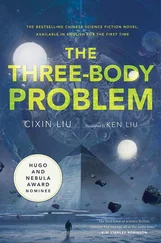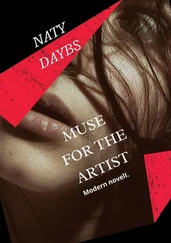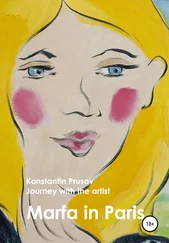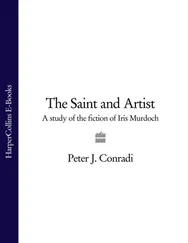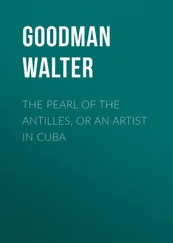Antique shops are an obvious place to start looking for appropriate and interesting objects, although these are often expensive. Charity shops and car boot sales are alternative sources of unusual items, going cheap. It is surprising how battered, rusty items can make good subjects for a still life, especially if placed in conjunction with something delicate and fresh. Imagine, for example, a composition created from a broken framed mirror and a few flowers, especially with the right kind of lighting. An anglepoise lamp, its light directed from an oblique angle, could provide dramatic lighting for a really interesting painting laden with ‘symbolic’ meaning.
Allow yourself to be influenced by the late still lifes of Cézanne, whose simple arrangements of everyday objects were the basis of a series of inspirational paintings. A plate, a glass and some apples can be all that is needed. If you are uncertain about handling complicated subjects, a simple arrangement of no more than three or four pieces of fruit is all you need.
Still Life with Glass Jug
42 × 56 cm (16 1/ 2× 22 in)
Just a few objects of varying colour, shape and texture can be stimulating to paint. I carefully drew and painted this set-up to provide a ‘realistic’ quality, but a much looser treatment can also make for an interesting painting. Keep your eyes open in antique shops for items that have particular qualities .
Think about a still life based on a particular theme – a kitchen-based subject, for example. Such simple items as a saucepan together with some vegetables imaginatively grouped together and suitably lit, could make a wonderful subject for a watercolour painting.
Kitchen equipment has lots of potential for still lifes. Choose from scales, mixers, sieves, bowls, knives, graters, whisks and similar items, plus the items of produce and foodstuffs that may be found in most kitchens. Broken crockery in the kitchen offers a marvellous subject for a still life. For example, a teapot, a sugar basin, a saucer, a broken cup and some spilt tea could make an intriguing painting.
Think about your subject matter well in advance of starting work. Do not just stretch a sheet of paper and then wonder how to fill the space. Always be on the lookout for suitable subjects and keep notes about your ideas.
You might see a painting in a gallery that could spark off an idea of your own, or two objects in conjunction with one another. Good subjects do not just present themselves – they have to be thought about and created through observation.
2
FRESH START
I don’t like this painting – it’s so tired and lifeless. Can you help?
Answered by:
John Mitchell
The first thing to appreciate is that, at times, everyone has this problem. Let us look at how you can give yourself the best chance of producing fresh and exciting works.
Choice of subject matter is important. Go for something original, not secondhand. Go for something exciting, not dull. Go for something you know about, something that arouses your curiosity, that ‘turns you on’. Fine words, but how do you do it? The answer is to explore the world around you in your sketchbook.
I cannot emphasize the benefits of using a sketchbook enough. Forget about copying other people’s paintings or photographs. Forget about that lovely calendar, or the postcard from a friend. Find your own subject matter. Here is a list to think about: family and friends, gardens, parks and holiday resorts, harbours and docks, beaches and woods, plant and mechanical forms. You could use a favourite poem or an excerpt from a book, even a piece of music. Visit exhibitions and look at art books to find inspiration.
I developed thumbnail composition sketches from a previous pencil sketch .
Launching right into a painting from a sketch without doing some pre-planning is a mistake. You may find, too late, that one object should not be in, or needs moving – so out comes the sponge to remove it. Perhaps that colour looks wrong – it has to be changed. Perhaps that dark area needs to be lightened. No wonder the colour quickly becomes tired and the paint surface deteriorates.
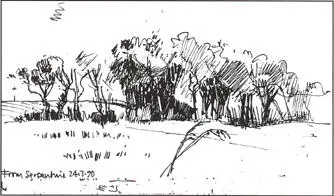
These two sketchbook studies were made in fine felt-tip pen in an A6 sketchbook. It is essential to collect source material in this way. As you finish each book, file it away safely. It will provide material for years to come .
Looking East from the Serpentine
12.5 × 28 cm (5 × 11 in)
This is a favourite location for landscape to which I return again and again. This version was developed from one of the thumbnail sketches illustrated opposite. I attempted to keep the colour fresh and lively throughout and worked to a limited amount of time .
Take time to plan your composition on a small scale before you start. Make a few thumbnail sketches to make sure everything is in the right place. Do a small colour sketch and even a tone sketch so that you can begin your final painting with confidence.
Think about the right size of paper for the idea. Obviously, a single book of watercolour paper limits you, so buy paper in individual sheets to have the option of working to any size. Give yourself enough room in which to work; every painting needs its own space.
Perhaps the subject would be best done on tinted paper. So why not try a small sketch or a range of colours before making up your mind?
Having got the composition and paper size right, think about some technical details, such as choosing a suitable brush. I frequently have to suggest to students that they should try using a larger brush. How can a fresh, exciting painting be made by fiddling away with a very small sable? It’s impossible. Sable brushes are expensive, but you do not have to use these. Ranges of excellent synthetic brushes are available. You could also experiment with decorator’s brushes.
It is worth trying out your different types of brushes to see what effects you can achieve. A sable brush will make a different mark from a harder hog brush, while a soft goat’s hair brush will be different from a synthetic bristle. A same size hake or chisel-shaped brush can be used to produce both broad and detailed marks.
Having chosen a suitable brush, use it to put the colour on, then leave the painted surface alone! Try not to fiddle with your painted areas once they are done. We are all tempted to go over areas we like but this must be resisted at all costs if a ‘tired’ painting is to be avoided.
A simple way of getting fresh colour is to use a limited range of pigments and to try to mix only two colours together. Here is my recommended list for a basic palette: Lemon Yellow, Cadmium Yellow, Cadmium Red, Permanent Rose, Coeruleum, and French Ultramarine. These six colours will give you unlimited mixtures. Adding Burnt Sienna and Burnt Umber will allow you to mix dark shades easily.
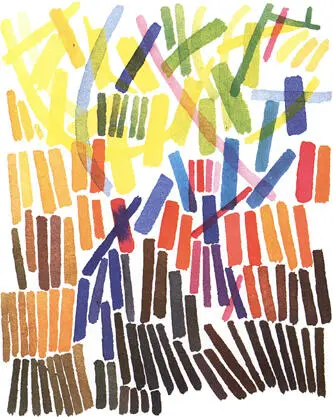
A sample range of colours from my suggested palette. Try using a restricted palette and explore it by making simple exercises .
Notice that I have omitted black. Unless used carefully black can produce a dirty-looking mixture. Mix French Ultramarine and Burnt Sienna or Burnt Umber to get a rich dark tone. All the illustrations for this chapter have been painted using this palette.
Читать дальше



